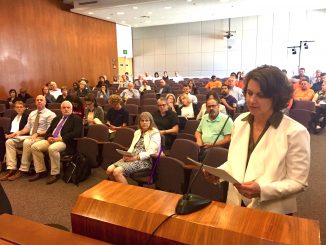
GUEST OPINION
BY PRIA GRAVES
While the public and elected officials are focused on Stanford’s 2018 General Use Permit (GUP) application and their proposed Development Agreement, there is another, quieter, aspect to the university’s expansion going on behind the scenes.
Over the past few years, though few people are aware of it, Stanford has been buying up numerous properties in our community. They have particularly focused on the College Terrace and Evergreen Park neighborhoods, where the current count is about 30, with no end in sight.
Why does this matter? These neighborhoods have always been home to many faculty members and students, who are a vital and treasured part of our community.
So what’s different about this?
The answer is that once the university owns these properties, they are only available to Stanford employees and will never again be accessible to the rest of the public. As with the faculty housing on campus, when Stanford “sells” these houses, it is on a ground lease basis, in which the university retains title to the land and the “purchaser” acquires the building and the right to use the land. If it is resold at some future date, it must again go to an eligible Stanford affiliate and so on down the years.
This means that folks who work in the Stanford Research Park or at one of our many Palo Alto tech companies and startups, at our local grocery stores and other local businesses cannot buy or rent these houses ever. They are permanently removed from the Palo Alto housing pool.
‘Ghost houses’
To make matters even worse, the university has been leaving many of these charming homes empty for months or even years, creating a “ghost house” environment in our neighborhood. Some blocks have as many as four vacant houses. This not only erodes our community cohesion but it makes us less safe since we have fewer “eyes on the street.”
And when they finally do take action, their typical choice seems to be to demolish these unique homes, many of which are over 100 years in age. Even though they claim that they are designing “sensitive” replacements, the new houses cannot possibly have the patina and history of the original homes being demolished.
For example, one home slated for demolition is a charming 110-year-old Craftsman Shingle Bungalow. It has lovely old wood paneling in the living and dining areas, has been freshly repainted, has a nearly new roof and a recent high-end kitchen makeover. Yet all this is destined for the landfill. And another that has already been scraped was a much-loved Cape Cod style house with an interesting garden.
All this demolition and construction in our densely populated little neighborhood is creating a nightmare for nearby residents but most importantly, it is a tragic truth that we are losing the special quirky character that makes College Terrace so appealing to many of us.
Loss of tax revenue
Stanford’s ownership of all these properties also has potential tax consequences for the community. While the houses are empty or even rented, no property tax is being collected. Thankfully the situation improves somewhat when they are “sold.” Although the purchaser pays less than market value (since the university retains title to the land), the assessor determines a “fair value” for the tax base, typically twice the price paid. But since the university is setting that price, it may not reflect the value of the house on the open market.
It’s not clear what can be done to stop this quiet land grab but perhaps the upcoming negotiations with Stanford regarding the 2018 GUP and their proposed Development Agreement might provide an opportunity for some leverage.
Our elected officials should insist that the university halt these unnecessary demolitions and require that any home they own should be kept occupied. Stanford is by no means the only one doing this, but given the number of properties they have acquired, their apparent desire to erase our history is terribly disturbing.
In the 1800s when Gov. Leland Stanford was buying land for the creation of the university, he tried to purchase the 120-acre parcel that is now College Terrace. The owners refused to sell, and in 1887 that land was subdivided. It now seems that the university is bent on completing the purchase where their founder failed!
Pria Graves is a botanical artist, sometime community activist, and former software engineer. She is currently serving as the College Terrace Residents’ Association Stanford Observer. She and her husband have lived in their historic College Terrace home for more than 30 years.




“demolition and construction in our densely populated little neighborhood is creating a nightmare.. ”
More so than you imagine.
Those 100 year old homes have lead paint both on the home and around them in the soil. That lead is powerful heavy metal nurotoxin (pb).
When Stanford repainted Escondido Village in 2013, they contaminated the entire area with old scraped and sanded lead paint that still poisons the children. The irresponsible admin found clever legal loopholes to feign ignorance.
Each demolition releases a cloud of nerotoxins into your community. I would get an air monitoring specialist involved and start sampling the air.
Good point! Thanks.
Please remember that the need for housing is pressing and real. There is a real and lasting cost to denying expanding housing opportunities for people who work nearby. If a tiny bungalow can instead house a family that joins the local community and schools, and takes a commuter off the roads from far away cheaper housing markets, that must have a benefit too. Palo Alto is changing, people need to get over their NiMBYism and recognize its costs.
Stanford is not a leader in that thought you are setting up. Nobody is going to disagree on you point. However, individualized lots in an established community isn’t the solution as much as Stanford might want to portray it as one. Nimbyism aside, right.
Before Stanford goes about getting an existing neighborhood without any study whatsoever, let’s wait for the Final Environmental Impact Report to come out https://www.paloaltoonline.com/news/2018/06/29/more-housing-but-worse-traffic-an-analysis-of-stanfords-housing-scenarios
My home in Barron Park is often described as charming and has been a fixture in the neighborhood for almost a century. It also is costly to maintain, hot in the summer, cold in the winter and occasionally hosts conventions of squirrels and other critters. While I love the creaky old place, I would never criticize the next owner for replacing it with a more energy-efficient, environmentally friendly home that new generations can enjoy for another 100 years.
Regarding the tax revenue, I hope the author is also pushing to repeal Prop 13. The tax basis on the home she has lived in for 30 years is far below market value.
It sounds like your home is wanting for maintenance not replacement. A timber-framed structure — like these older homes usually are — have a serviceable life of 500 years. Until then, you can wrap all the sustainable goodness you want around that frame (double pane windows, wall and attic insulation, new electrical and plumbing); you should be substantially replacing these every fifty years anyway. If you still have wall outlets from the ’60s, call an electrician, right. You can keep a feel of a neighborhood without living in the ’19th century.
Thank you Pria for keeping track of the homes Stanford has gobbled up. I wouldn’t be concerned about such a thing except that it will hurt our school district. As I understand it (and correct me if I’m wrong), but if Stanford declares a home is to be used for the academic purposes of the university, it’s exempt from property taxes. So if a professor or teaching assistant moves in, goodbye to the property taxes.
It would be helpful if Pria or PAUSD took the list of homes Stanford has bought and calculate how much Stanford has been able to avoid in property taxes.
Then take the total Stanford has saved and turn it into a bill. The next time Stanford’s Jean Mccown sits down with Simitian to negotiate the GUP, Simitian should hand her the bill and say, “Jean, the negotiations are on hold until you cut a check for the total and the check clears the bank.”
That’s a fantasy. Stanford always wiggles out of its responsibilities, and politicians like Simitian let them get away with it. They’ll find a loophole to avoid paying their fair share, and the cost of their expansion will be thrown onto the backs of Palo Alto residents.
If somebody selling their house gets multiple offers at the same price, and one of the offers is from Stanford, I would hope that the seller would go with another buyer than Stanford.
@Rich, it seems you didn’t read the part of the article where Pria specifically describes how these homes are subject to property tax, and they are assessed by the county at roughly 2x the actual sale price. While Pria raised concerns that this may not be sufficient to reach market value, my understanding is that the County actually sets the FMV individually for each property, which negate this concern.
Sadly, Stanford has become my Alma Mater, Build on
every space of land available UC Berkeley…
Land off 280 is next!
III
Are property taxes waived while the house is vacant or rented? Is this only in Palo Alto? News to me.
Judging by the comments, this situation is hopeless and the current residents of PA are just as guilty of balkanizing and destroying their own neighborhood as Stanford. How many native Palo Altans even live there anymore? 1%? What if no houses were bulldozed but only Indians and Chinese moved in, would it be ok then? These are the fruits of the rootless cosmopolitanism that cheered mass migration and sneer at “nativists” who prefer to live in normal neighborhoods with neighbors that share their values and culture and don’t skip town looking for the next multicultural thrill at the expense of their own nation.